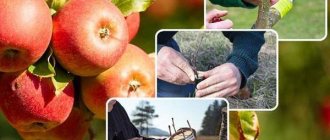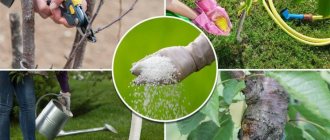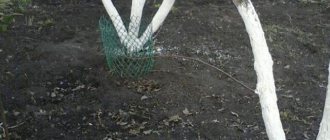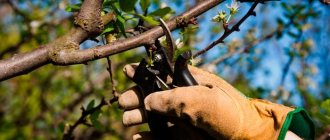Correctly done pruning can keep the plant strong, strong and beautiful. In fruit trees, the quality and quantity of the harvest is significantly improved. The most suitable time for circumcision is the end of winter and the beginning of spring. At this time, the plant is dormant, all growth processes are still very slow, and the wood is no longer frozen. In this article we will look at the types of pruning of fruit trees and find out when it is better to prune them - in spring or autumn.
Why is pruning needed?
Pruning is carried out for the correct formation of the crown, as well as for sanitary cleaning of diseased, damaged and dried branches.
If pruning is done correctly, it will not only improve the condition of the plants, but will also prevent large amounts of snow from accumulating on the branches and prevent branches from breaking.
Why is it important to trim trees:
- the plant is better illuminated;
- better ventilated;
- gets sick less often;
- the tree produces beautiful and large fruits;
- begins to bear fruit earlier, and the fruiting period lasts longer;
- the tree looks neat and well-groomed.
The main pruning of heat-loving crops is recommended to be done in the spring. However, autumn pruning also has its advantages:
- plants have time to recover from injuries before the onset of frost, and in the spring they immediately begin active growth;
- fruit trees tolerate cold weather more easily; because the thinned crown does not accumulate snow, there is no risk of kinks;
- the plant does not become infected with fungal infections, since at this time the fungi are already “sleeping”;
- A summer resident has less work to do in the fall than in the spring and summer.
But don't get too carried away. Despite all the benefits of pruning, this procedure is very stressful for the tree. Excessive pruning will damage the trees and the yield will be significantly reduced.
Technology for pruning branches in spring
Tree sawing is an ancient agrotechnical technique. There are several methods for pruning branches:
- Bud pruning. This method is needed to direct the growth of branches in the desired direction. We find a one-year-old branch and look for a bud on it that looks in the direction we need. We position the pruning shears so that it is slightly higher than the bud. Angle – 45%. There is no need to tilt it any further so that the sap flow is not disrupted.
- Filing into a ring. This method is needed to remove excess branches, because the tree wastes nutrients on them. First, select a tool based on the size of the shoot. We prune so that there is no stump left, but not too deep so that there is no wound. That is, along a circular flow.
- Pruning for lateral branching. This method is needed to redistribute tree resources from one branch to another. Thus, the growth of new fruiting shoots is stimulated.
ON A NOTE. These methods help lighten the load on the plant and increase the amount of light penetrating into the tree.
When to prune fruit trees in the fall
It is difficult to name the exact date of pruning. Firstly, it all depends on the climate in your region and the weather in this particular season, and secondly, in general there are no strict requirements for dates. The main thing is not to miss the time during which pruning will take place without harm to the trees and the future harvest.
The gardener chooses the time of pruning in the fall himself. But you can focus on the following criteria:
- all work in the garden has already been completed (the trees have been fed, disinfected, mulched, watered);
- the leaves have fallen and been removed from under the trees;
- the weather is dry and cool;
- There are still 2-3 weeks left until stable negative temperatures.
As a rule, in the middle zone this time falls on mid-October - the first ten days of November. In the southern and northern regions, the dates are shifted.
Start autumn pruning after leaf fall, when sap flow stops and the plants begin a period of rest. And complete the process 2-3 weeks before the onset of frost. This way, cutting will not weaken the plants, but, on the contrary, will strengthen their immunity.
- Preparing the garden for winter: what work to do in the fall
We tell you what the autumn preparation of the garden for winter involves.
What to pay attention to when pruning
You should not prune trees ahead of schedule. Pruning, for example, apple trees in September, which is sometimes practiced by hasty summer residents, will not do anything good. At this time, the leaves are still firmly attached to the trees, and it will be more difficult to see the crown.
- Pruning trees and shrubs - tips and tricks
How to prune trees and shrubs for a beginner and what you need to know for this - find out from our article!
Late pruning is also fraught with consequences. The plants will not have time to recover before the onset of cold weather, so the bark at the cut site may freeze. This will lead to drying out of the wood and subsequent death of green spaces.
It is important that pruning takes place on a dry, clear day. It is not advisable to prune trees during rain or immediately after it.
Carry out work in the garden with sharply sharpened and disinfected garden tools (secateurs, hacksaw). Otherwise, instead of practical benefit, you will provoke disease in your plants. Prepare a stepladder and gloves in advance. Treat the cut areas with RanNet, BlagoSad, Zhivitsa or garden varnish.
What should I do to legally trim a tree?
In order not to make mistakes and harm the plantings, as well as to avoid breaking the law, it is recommended not to act on your own, especially if you have no experience in this. This is especially true for those plantings that are included in the register of monuments and cultural values of the city. For their damage, as well as actions that led to the death of the tree, the perpetrators may be held criminally liable.
Therefore, it is first necessary to clarify the status of a particular planting. And if there are certain restrictions regarding it, you need to obtain permission from the local municipal authority.
For reference! The restrictions do not apply to fruit trees, as well as plantings that are not older than 10 years.
How to trim trees correctly
When pruning in autumn:
- carry out sanitary cutting of shoots;
- remove diseased branches affected by pests, as well as those that have dried out or broken;
- cut off all root shoots and tops. They only thicken the crown, draw in food for themselves, but are not needed for fruiting;
- remove weak, immature branches, as well as crossing and closely growing ones;
- get rid of shoots that grow inside the crown or vertically upward. The tree also does not need branches that point downwards.
All cut branches are removed from the site or burned.
Leave those branches that grow perpendicular to the trunk. They will give the greatest harvest.
Schemes of crown formation in spring
There are many schemes for forming the crown of fruit trees in the spring. Below we will look at just a few of the most interesting and effective ones.
Why is it necessary to form a crown? To grow strong skeletal branches that will support the weight of the fruit. The second reason is to limit the growth of the tree and stimulate fruit formation.
So, 4 schemes for crown formation in spring.
- Tiered (tiered rarefaction). Common method. Its essence is to preserve the natural appearance of the tree. Externally, the crown with this filing resembles a pyramid directed upward.
- Vertical (vertical palmette). This crown formation pattern represents the development of lateral, almost horizontal skeletal branches.
- Fusiform. This scheme is suitable for stone fruits (apricot, plum). The crown is formed in the form of an oval.
- Cup-shaped. The essence of this scheme is to form a bowl from the lateral skeletal branches. In this case, the central trunk is shortened. This scheme is suitable for the most capricious plants (for example, peach).
Pruning an apple tree in autumn
When to prune : The procedure begins immediately after the leaves fall and is completed before the onset of frost. In the middle zone, this time usually falls in mid-October - early November.
What to trim : Cut out damaged, dried, weakened and close-growing branches.
- How to get rid of an extra trunk on an apple and pear tree
A double trunk can kill a tree. We will tell you in this article how to get rid of an extra trunk and what to do if an apple or pear tree is cracked.
Rejuvenating pruning of old apple trees is carried out gradually, over 2-3 seasons. In the first year, a third of the old branches are cut out, the next year another third, and the last third is left for the third year.
In the year of planting, an annual seedling may have no branches, or only a few underdeveloped branches. In the first case, it is shortened to 80-100 cm. In the second, the central conductor is shortened, and the branches growing in the area of the future trunk at a height of up to 70 cm from the ground are removed. The same applies to those located higher up the trunk, but at an acute angle to it. But those that extend from the trunk at almost a right angle are left, shortening up to 3-5 buds from the trunk.
In the second year of life, the seedling is left with 3-5 of the strongest and correctly placed branches. The central conductor is also shortened so that it is only 20 cm above the upper branches. If a second “candidate” for conductor appears, he is also cut out.
For 3-5 years of life, pruning of the apple tree is reduced to a minimum. The gardener cuts out tops, damaged branches, as well as those shoots that grow deep into the crown or rub against others.
- Pruning apple trees in autumn - tips for beginners in pictures and videos
Now is the best time to prune apple trees in the fall. Don't know how to do it right? Then watch our diagrams and detailed videos.
Processing wood after cutting. Timing for processing stumps on fruit trees
The timing of covering cuts on apple trees depends on the time of year and current weather conditions. So in the fall, during the heavy rainy season, the cuts dry poorly and take a long time - sometimes you have to wait at least a week for the wound to stop getting wet and to be fully treated. In sunny, warm weather, saw cuts dry out in just a couple of days.
During summer pruning, only very young, not yet woody shoots need to be removed. Small-diameter sections heal quickly on their own and do not require special treatments. At low air temperatures, wounds practically do not heal at all, even with proper treatment.
In winter, cuttings are not processed at all.
Sections whose diameter does not exceed 2.5 cm are disinfected, but not covered with anything. They tighten themselves quickly enough and do not pose a danger to the tree. With saw cuts more than 3 cm in diameter, they work strictly according to plan - immediately after trimming, the wound is cleaned of roughness and burrs using a sharp garden knife, the saw cuts are coated with a brush with a special solution that will disinfect the wound and protect it from bacteria and infections. Then the cut is left to dry for several days; after this period, it is treated with a special agent, without affecting the tree bark along the outer parts of the cut. If the bark was damaged by rodents in winter, it cracked due to temperature fluctuations or received sunburn, treatment is carried out in the spring (the temperature should be above zero). Damaged areas are cleaned down to healthy wood, then treatment is carried out according to the same scheme as after seasonal pruning.
Pruning pears in autumn
When to prune : Timing depends on the variety, growing region and weather conditions. You can start pruning pears in the fall after fruiting has ended: this is the period from the end of August (in the northern regions) to the beginning of November (in the southern regions), two to three weeks before the first frost.
The suitable temperature for the operation is 8-12°C.
Trees of early varieties or varieties with low winter hardiness are pruned first so that they have enough time to recover. Frost-resistant pears are pruned before the end of October - beginning of November.
If you missed the deadline for pear pruning, it is better to postpone the procedure until spring. Otherwise, the tree may not cope with stress and will not survive the winter well.
What to prune : Remove dead and diseased branches. Cut off the young basal shoots, trim the tops, thin out the crown. Trim branches that you will remove in the spring. Trim the annual growth to a bud. Also remove branches that grow inward. Side branches that interfere with the penetration of light are removed “in a ring”.
An annual tree is pruned at a height of 45-65 cm from the soil level. For two-year-old specimens, 3-4 skeletal branches are left, they are pruned at the same level, and the remaining shoots are removed. The conductor is cut 20 cm above the main branches.
a – branches growing too close, b – branches pointing down, c – branches pointing towards the side of the trunk, d – branches crossing
Older trees are mainly subjected to sanitary pruning.
- Pruning pears in the fall for beginners: visual diagrams, clear tips
Autumn pruning raises many questions for novice gardeners. Let's figure out which branches need to be removed from the pear and when is the best time to do this so that the tree survives the winter well and pleases you with juicy fruits next season.
To rejuvenate an old pear, first shorten its top. But if proper pruning has been carried out annually, then you can immediately begin thinning - remove non-fruit-bearing, dry, old branches, cut out shoots that grow parallel to the trunk or at an acute angle to it. All other shoots are shortened by 1/4 of the length.
Subtleties of the process
When pruning trees, you must be very careful, and be sure to follow the basic rules, which will prevent harm to the plants. First of all, you need to decide on the appropriate pruning season. This depends on the type and age of the fruit trees, as well as the location of the garden and climatic conditions.
The tools needed to carry out the procedure play a big role in the outcome of pruning. To avoid damaging the plant, cut branches only with sharp stainless steel tools. The set includes the following items:
- garden hacksaw;
- glasses;
- pruner;
- stairs;
- air pruner;
- garden varnish or drying oil paint.
Do not use rusty tools, as this may cause the tree to become diseased and die. Before the procedure, the purposes of its implementation are determined:
- preparation for winter;
- formation of the correct tree crown;
- increasing the number of fruiting branches;
- strengthening thin young shoots;
- removal of diseased branches;
- removing crossing branches;
- thinning the crown to allow sunlight to enter.
Reducing the main number of fruiting buds will help you cope as quickly as possible so that the fruit tree grows quickly. After determining the goal, studying the technique is equally important. Technique:
- Side branch cut. This technique helps to change the direction of growth from one shoot to another. It is necessary to cut off non-fruit-bearing branches, thereby transferring the function of dominance to the side branches.
- Kidney cut. This technique allows you to help the branch grow in the right direction. It is necessary to find a branch with good growth. You need to turn the cutting blade of the pruning shears towards the remaining part of the branch. Make a cut at a slight angle of 5 mm in front of the bud. The new branch will grow towards the bud.
- Ring cut. The technology is performed to get rid of a full-fledged branch growing inside the crown. This is required for thinning and space for the remaining branches. Pruning is carried out at the junction of the branches. This is done exactly along the outer ring.
We recommend watching a video in which a gardener shares the intricacies of pruning trees in the spring:
Pruning plum trees in autumn
When to prune : The tree is pruned from mid-September to the end of October, after leaf fall, so that it has time to prepare for wintering. It is advisable to do it 2-3 weeks before the first frost.
What to trim : Long and fast-growing branches are shortened by a third so that they do not break under the weight of snow and gusty winds. If necessary, you can shorten the top of the tree. All damaged and broken shoots are also cut out, since they are more susceptible to frost than others. At this time, dry and diseased branches of an old plum tree are pruned.
- Proper pruning of plums - tips for beginners (diagrams, photos, videos)
We tell you how to prune plum trees in spring, summer and autumn.
In regions with mild winters, not only sanitary, but also formative pruning is carried out in the fall. If the top extends above 2.5 m, it is shortened. After this, shoots that grow too quickly are cut off. Competitor shoots are cut out, which will actively grow in the spring and thicken the crown, preventing the sun's rays from illuminating all parts of the plant. In the unstable climate of the middle zone, it is better to postpone this matter until spring.
It is impossible to fully prune a plum in the fall in the year of the tree’s first fruiting - in this case, only problem branches are removed.
What are the features of the procedure in spring?
First of all, let's talk about some of the nuances of the procedure.
- Prepare your instrument. Secateurs, saws, loppers - everything must be sharpened and disinfected. This is necessary so that the cuts are neat and infection does not get inside.
- Get the right tool. You will have to remove both large and small knots. Everyone needs the right tool. Firstly, it will simply be more convenient for you to work. Secondly, you do not injure the shoots.
- Don't be too overzealous when working with young trees. You just need to shape the crown, remove diseased branches, and also remove growth so that there is no competition.
- When removing a thick branch, first saw it from the bottom, and only then saw it from the top. This way, your branch will not break off and pull the bark along with it.
- Be careful with your kidneys! When pruning to the bud, hold the cutting tool at an angle of 45 degrees and point it towards the top of the branch. The upper corner of the cut should be a couple of mm above the bud.
Pruning cherries in autumn
When to prune : Work is carried out from September to early November, depending on the weather in your region: the warmer it is, the later you can start working. The main indicator is leaf fall. At this moment, sap flow inside the trunk ends, and the tree will tolerate the loss of branches more easily. But it’s important to get there before frost!
What to prune : Autumn pruning of cherries is usually of a sanitary nature. Remove dry, diseased and damaged branches that can become sources of infection. And also thickening branches that grow inside the trunk, branches that “look” down, young basal shoots. Also trim tops, young growth on the trunk, lower branches at forks and crossing shoots.
Leave the formation of the crown for the spring.
Do not prune one-year-old seedlings in the fall, as well as young immature plants. It's better to do this in spring or summer. Subject the remaining trees to the procedure only if they are generally strong and healthy.
- Pruning cherries in the fall - tips for beginners in pictures
We tell you which specific branches need to be removed so that the trees develop properly and bear fruit abundantly in the future.
Choosing a tool and cutting technique - doing everything right
Trees should only be trimmed using tools such as pruning shears or a garden hacksaw. To cut branches at hard-to-reach distances, a circuit or device called an “air pruner” is used. It is a long telescopic stick on which a standard pruner is attached, and is driven by ropes attached to it.
It is better to use a regular pruner, without a ratchet mechanism, with sharp blades. This will allow you to delete branches with one click. When choosing a hacksaw, pay attention to the presence of gaps in the teeth that prevent the accumulation of sawdust. Never use construction tools to avoid damaging the wood.
All tools must be clean and sharp to avoid the formation of torn surfaces on small and large branches through which unwanted microorganisms penetrate the tree. Additionally, it is recommended to use natural oil paint or a special garden ointment based on petroleum products. With their help, it is necessary to cover up small and large wounds on the tree.











